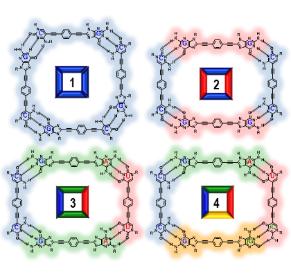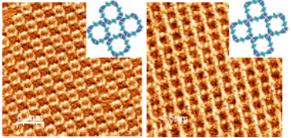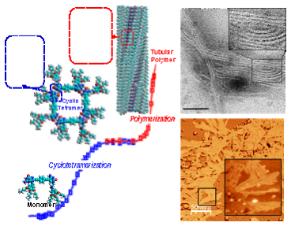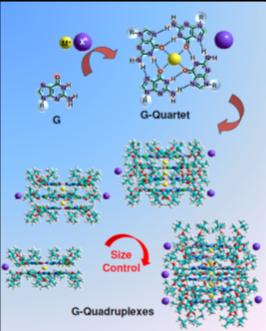Welcome to the Nanostructured Molecular Systems and Materials group at the Universidad Autónoma de Madrid.
Our research interests broadly aim at improving or creating new functions in organic materials by rationally ordering molecules at the nanoscale using the tools of self-assembly. We are focused on the development of new supramolecular strategies for the construction of complex molecular architectures with unprecedented structures, exciting physical and biological properties, and unconventional applications.
The biological world is a shining example and a source of inspiration when it comes to the organization of molecules. Nature has chosen the unlimited possibilities of Self-assembly to precisely define the structure of molecules, organize them, and create a wide diversity of perfectly defined nanosystems having particular functions. The structure of viral capsids and cell membranes, the precise dye organization within photosynthetic reaction centers, the integration and disintegration dynamics of the microtubules forming the cell skeleton, or the polymorphism of DNA and proteins are just some representative examples.
The way molecules interact and communicate with their environment and the way they are organized into larger architectures, is by means of Non-covalent Supramolecular Interactions. Molecules can be "programmed" with chemical information in order to recognize and specifically associate to other molecules. The importance and complexity of these self-assembly processes represent a continuous inspiration to scientist in their quest for the engineering of complex functional nanostructures through a bioinspired "Bottom-Up" approach.
The group's research is centered in Molecular Engineering. We 1) design and 2) synthesize new functional molecules - from biologically relevant molecules to π-conjugated dyes -, 3) program them with specific supramolecular information - in order to guide their assembly into a given nanostructure -, and 4) study how the system properties relate to molecular structure and supramolecular architecture. In collaboration with several groups of chemical physicists and molecular biologists, we are exploring unconventional and exciting applications of our nanostructured systems and materials in diverse multidisciplinary areas, such as organic optoelectronics, molecular recognition and catalysis, advanced materials, or biomedicine.
Widely used by nature in defining the structure of biomolecules, hydrogen bonding is regarded as a powerful means to control supramolecular architecture, since it is a directional, selective and strength-tunable non-covalent interaction.
In our group we want to profit from the attributes of this extraordinary interaction to selectively build different kinds of polyhedral nanoobjects. H-bonding directors - i.e. fragments having an array of H-bonding donor and aceptors groups -, such as nucleoside derivatives, are strategically coupled to rigid blocks so as to guide their assembly into just one specific, well-defined structure. The different functional components in these discrete nanoobjects can cooperate so that the assemble may display a specific property.
See for example:
J. Am. Chem. Soc. 2013, 135, 19311
Angew. Chem. Int. Ed. 2015, 54, 6780
Org. Lett. 2015, 17, 2664
Angew. Chem. Int. Ed. 2016, 55, 223
ChemistryOpen 2016, 5, 10

We pursue the synthesis of systems and materials by supramolecular polymerization, that is, a polymerization process where the monomeric repeat units are held together by noncovalent bonds, such as metal-ligand coordination, π-π dispersive, dipolar, or H-bonding interactions. The careful design of the self-assembling building blocks and the control of the interplay between multiple non-covalent interactions will define the dimensionality of such systems.
1D Nanofibers or nanowires made of stacked functional π-conjugated molecules in which we will try to rule stack length and composition.
2D Networks grown onto metal or graphitic surfaces and 2D layered materials where we will try to control molecular positioning.
3D ordered frameworks that are built by combination of different reversible non-covalent or covalent reactions and that will be endowed with custom-tailored nanochannels. These systems may find application as nanomembranes for advanced separation technologies.
See, for example
Chem. Mater. 2011, 23, 310
Angew. Chem. Int. Ed. 2015, 54, 2543
Angew. Chem. Int. Ed. 2016, 55, 659

We aim to understand the fundamentals of chemical self-assembly and contribute to the development of the full potential of noncovalent synthesis to prepare, in a bioinspired manner, complex functional architectures. One of our objectives is to establish unconventional and versatile strategies towards self-assembled nanotubes whose size, composition, internal structure, and function can be rationally predesigned and controlled at the nanoscale. In a first stage, specific cyclic entities are formed by H-bonding interactions. These discrete macrocycles then stack through nucleation-growth polymerizations into highly ordered tubular nanostructures guided by the cooperative action of parallel directors. The combination of computational chemistry and diverse spectroscopy and microscopy techniques will allow us to study the thermodynamics, kinetics and mechanistic pathways of the different supramolecular processes intervening in nanotube assembly, both in water and in organic solvents.
Furthermore, our goal is to do chemistry within these chiral confined nanospaces. As a matter of fact, we can regulate the diameter and chemical coating of the tubes’ pore, so as to selectively host diverse guest molecules as a function of their size and chemical affinity.
See, for example
J.Am.Chem.Soc. 2019, 41, 16432
Angew. Chem. Int. Ed. 2020, 59, 17091-17096. DOI: 10.1002/anie.202006877 (VIP paper)

DNA is a biopolymer with predictable and programmable interactions that can be used as a versatile self-assembling building block in nanotechnology for a wide range of potential applications: highly specific sensors, cell-surface engineering, molecular computing, etc. In one of our research lines within this topic we plan to radically alter DNA self-assembly at the deepest level: the interaction between bases. Using properly designed nucleobase chemical modifications, a DNA quadruplex structure, having a cyclic section and a chiral, tunable inner pore, spontaneously evolves from the programmed self-recognition of 4 oligonucleotide strands. These well-defined DNA-based nanoobjects may offer a huge number of applied possibilities, like their use as nanocontainers for drug delivery or transmembrane channel mimics. Additionally, the group is investigating the use of DNA single strands to guide the stacking of π-conjugated molecules via a template effect. In this way, the group expects to have a fine control on the polydispersity, length and sequence of the stacks.
In a related research line, we have been studying the self-assembly of guanosine derivatives into G-quadruplexes, which constitute a remarkable example of self-assembled, discrete nanoobjects. These assemblies comprise H-bonded cyclic tetramers (G-quartets) that can incorporate size-matching metal cations by coordination to the carbonyl groups between π-π stacked quartets. We and other research groups have considered G-quadruplexes as ideal scaffolds to which functional organic molecules can be attached to build well-defined nanoclusters that are endowed with physical properties markedly different from their molecular constituents.
See, for example
Nature Chem. 2009, 1, 151
J. Am. Chem.Soc. 2010, 132, 4710
Chem. Commun. 2016, 52, 9446
Org.Lett. 2017, 19, 460
Org. Lett. 2020, 22, 41
Angew. Chem. Int. Ed. 2020, 59, 9041

The supramolecular synthesis of systems and materials in which the morphology and the relative arrangement of individual π-conjugated molecules can be controlled is a challenging objective that requires scientific attention, so that function and optoelectronic properties can be related to well-defined nanostructures with a designed molecular organization. In collaboration with different groups, a central project in this line focuses on the organization of cone-shaped π-conjugated molecules with axial dipolar moment into non-centrosymmetric columnar nanostructures and liquid crystalline materials, which present switchable (i.e. ferroelectric) or permanent polarization that can be coupled to charge transport. Other current objectives that are under development combine noncovalent strategies and methods from the above-mentioned topics that employ nucleobase derivatives as supramolecular directors to control the self-assembly of p- and n-type semiconductors. Achieving a rational, controlled molecular organization at the nanoscale may help us to understand charge separation and exciton/charge migration phenomena in order to optimize the performance of optoelectronic devices, such as organic solar cells.
See, for example
J.Am. Chem.Soc. 2010, 132, 4710
J.Am.Chem.Soc. 2013, 135, 19311
J.Mater.Chem.C. 2015, 3, 985
Angew.Chem.Int.Ed. 2015, 54, 2543
Adv.Mater. 2015, 27, 4280
Chem. Commun. 2016, 52, 9793
Science Adv. 2017, 3, e1701017

A more recent research line directly applies some of the supramolecular concepts and tools developed in the group to polymeric materials. One of the projects in this line ultimately targets the preparation of adhesive polymer coatings where bonding occurs under a pressure-sensitive contact mechanism between two complementary surfaces, thus chemically mimicking the operation of materials like magnets or Velcro®. A second project plans to introduce non-covalent, multivalent, cooperative interactions in supramolecular polymers with the aim to target self-healing thermoplastic polymers and hydrogels.
See, for example
ChemistryOpen 2020, 9, 409

Universidad Autónoma de Madrid © 2008 · Ciudad Universitaria de Cantoblanco · 28049 Madrid · Información y Conserjería: 91 497 43 31 E-mail: informacion.ciencias@uam.es Gestión de estudiantes de Grado y Posgrado: 91 497 8264 / 4329 / 4353 / 4349 / 6879 / 8362 E-mail: administracion.ciencias@uam.es